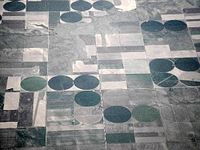
Photo from wikipedia
Utilizing a data set of 399 Namibian commercial cattle farmers, we provide a detailed empirical analysis of farm management under highly variable rainfall. Particularly, we provide an econometric analysis of… Click to show full abstract
Utilizing a data set of 399 Namibian commercial cattle farmers, we provide a detailed empirical analysis of farm management under highly variable rainfall. Particularly, we provide an econometric analysis of what personal characteristics of the farmer, environmental characteristics, and characteristics of the farm explain farm size and choice of stocking rate, i.e. the heads of livestock per hectare. There is strong support for the hypothesis that environmental variables such as inter-annual rainfall variability play an important role in explaining stocking rate, but not in explaining farm size in the sense of rangeland area or cattle numbers. Other major explaining factors for the stocking rate are the farmer's gender and the number of cattle on farm above a certain threshold given by a fit of the Pareto distribution to the data. Traditional farm size variables like cattle number and rangeland area are not well explained by any of the candidate models constructed, which supports the view that the stocking rate is the central farm management parameter.
Journal Title: Land Use Policy
Year Published: 2019
Link to full text (if available)
Share on Social Media: Sign Up to like & get
recommendations!